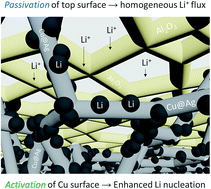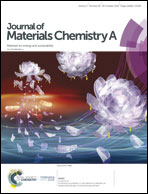Efficient and robust lithium metal electrodes enabled by synergistic surface activation–passivation of copper frameworks†
Abstract
Although Li metal electrodes can increase the energy density of rechargeable batteries, they suffer from short cycle lifetimes and pose safety concerns due to large volume changes and dendritic growth during repeated Li plating–stripping. Consequently, there is increasing interest in the development of three-dimensional (3D) Cu frameworks that can host metallic Li; however, uneven Li plating in 3D architectures still remains a crucial issue. Herein, a strategy involving the synergistic surface activation–passivation of 3D-Cu frameworks is proposed, which enables efficient and robust Li metal electrodes. A conformal, lithiophilic Ag nano-layer formed via galvanic displacement activates Li nucleation over the entire 3D-Cu surface, while an inert, non-conductive Al2O3 coating passivates the top surface of 3D-Cu, facilitating homogeneous Li+ flux into the porous framework and suppressing preferential Li plating on top of the framework. The synergistic surface tailoring results in high coulombic efficiency (>98%) and stable cycling performance, even without any optimization of the porous architecture; this confirms the uniform and reversible Li plating–stripping inside the 3D-Cu framework.



 Please wait while we load your content...
Please wait while we load your content...